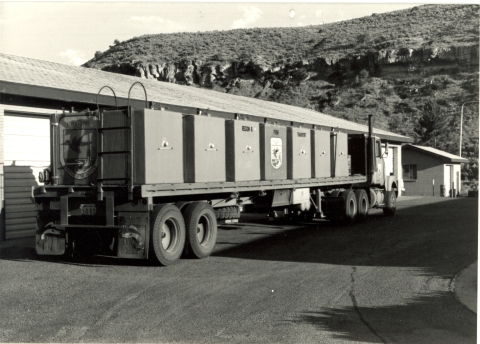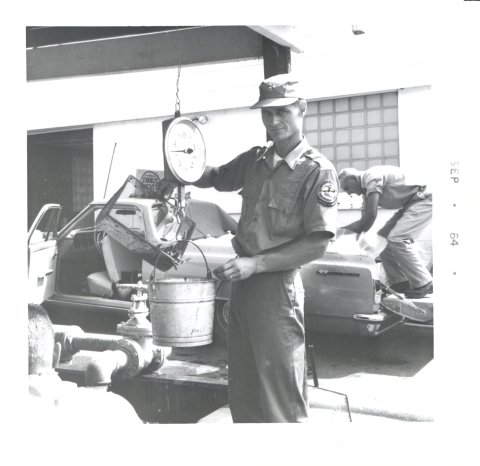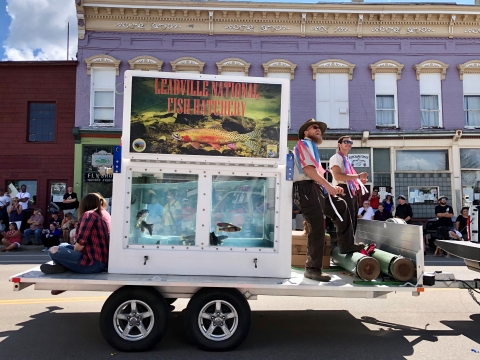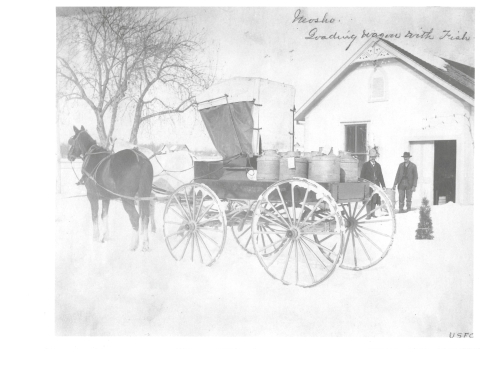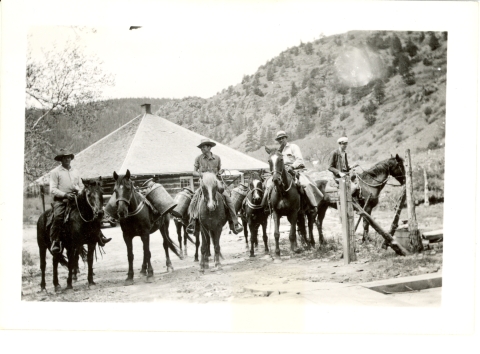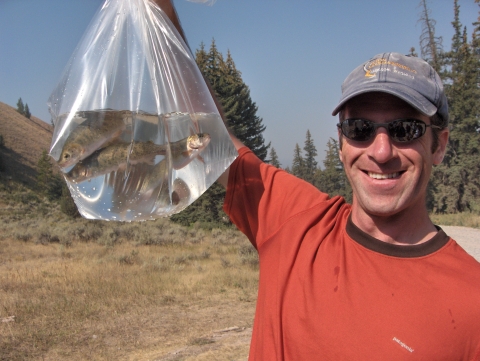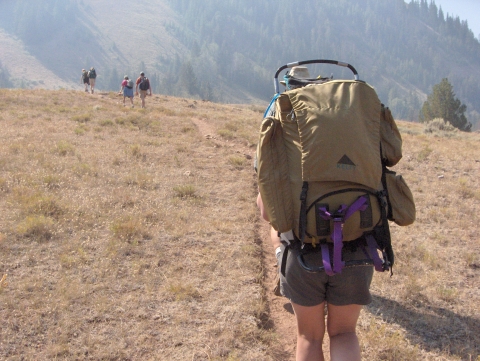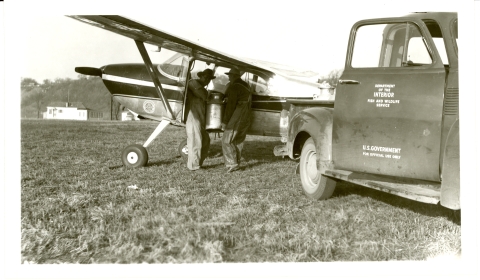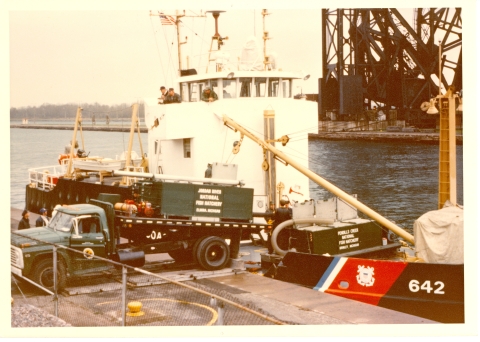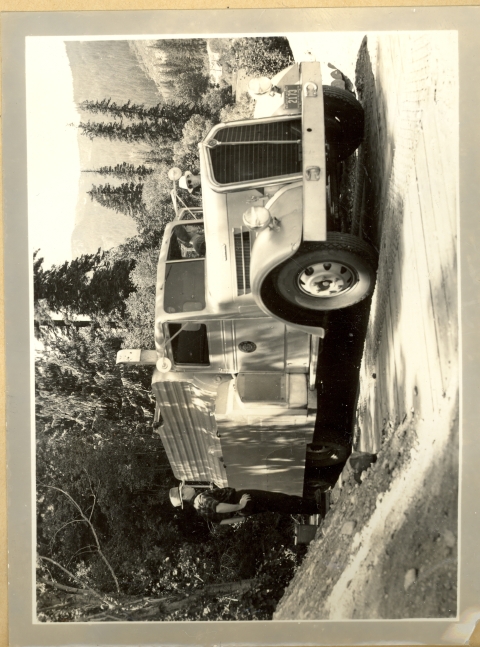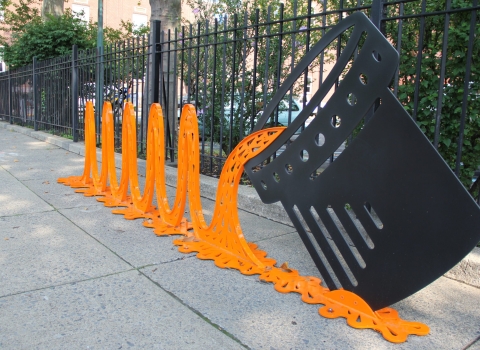You know what gets the U.S. Fish and Wildlife Service amped up as much as healthy fish? Stocking those fish, of course. But why do we love saying goodbye to the fish we’ve cared for so much? Glad you asked. It provides multiple benefits like restoring declining fish populations in their native habitats, providing recreational opportunities for anglers, keeping fish on Tribal lands, and much more.
The National Fish Hatchery System stocks fish all over the country for folks to enjoy. Each year we raise close to 75 species including ever popular walleye, bass, cutthroat and salmon. In 2021, we surpassed over 110 million fish released to support conservation and recreation. And our recreational fish stocking program contributes $1.2 billion a year to local economies!
Fun Fact: We are also in the fish egg business! Our National Broodstock Program transferred 81 million eggs in 2021, sometimes hand delivered, but often via mail like FedEx or UPS. It comes with challenges, and may require recreating history at times, but it explains how a hatchery in Wyoming can get time sensitive eggs speedily to Tennessee. Oh technology. And then those eggs hatch into fish that need to be stocked!
Fish stocking is a historic management practice that we still utilize today - some of it dating back over a century and a half. Since 1871, we have been working to improve recreational fishing and restore aquatic species that are important to the health of our aquatic systems. We support fisheries that have been impacted by federal dams from California to Kentucky, and help recover species once thought lost forever.
Releasing fish where they need to be can get complicated, but we’ve managed to find some creative ways over the years to get the job done while prioritizing fish health and safety. And speaking of fish health, our hatchery system can achieve so much in large part due to our amazing Fish Health Centers. And not only do they keep the fish we raise happy, they also work hard to protect wild populations too. Kudos to them and their assistance in stocking robust fish via our many ways below!
Precious Cargo
This is our current most common method – a fish distribution truck! The fish are placed into special tanks that keep them safe and comfortable with aerated water and injected oxygen. A vehicle may be as big as a semi-truck to transport tens of thousands at once, or smaller with 4WD for remote locations. These days trucks may even be adorned with a special image on the side, or a see-through wall for fish viewing! Some stocking trips cross several states and many hours of the fish asking, “Are we there yet?”
Is an El Camino a truck? Or a car? Either way this guy knows it's cool, and it was successfully used in 1964 to drive these fish to a new home. Using this method they would inject oxygen into plastic bags filled with water and fish. The top would be tied off, mostly likely with a heavy-duty rubber band of sorts. The bed of the truck would secure the bags until reaching their destination, and then the biologists could listen to the #1 hit song "I Want to Hold Your Hand" by the Beatles on the way home!
Most hatchery trucks have their name printed on the side. Why not jazz it up with a colorful picture or vinyl tank wrap?! It's a hot new trend, and also serves as an outreach tool while driving down the road. "Ooh look at that cool fish! I want to see one in person at that fish hatchery!" A moving billboard that shows how proud we are to provide fishing opportunities and champion conservation efforts.
All Aboard!
Before we had tanker trucks and the other insulated methods, fish were stored in milk cans or buckets and carried by railcar, horseback and wagons. During a time known as the Fish Car Era, 10 specially designed railcars moved fish quickly around the country. According to the National Fish and Aquatic Conservation Archives, by 1920 fish cars had carried over 72 billion fish across 2 million miles of railroad. That’s a lot of sightseeing.
The oldest federal fish hatchery in operation is the Neosho National Fish Hatchery in Missouri. It was established way way way back in 1888. Not a lot of options for moving fish at the time, so horse-drawn wagon it was. Using an animal to move an animal, what a twist!
Horses not only pulled wagons, they also carried milk cans with fish themselves. It looks like the ride might have been a little sloppy and wet for the horses, but if it was hot summer day they probably didn't mind. These days horses are still used occasionally, but hard-sided panniers or saddlebags are hung on each side and carry a sealed plastic bag with fish. It's like a modern day Pony Express delivery.
Not Your Average Hike
When no roads exist, sometimes it’s necessary to strap on our packs and start walking! Hiking into remote areas may not result in thousands of fish finding a new spot, but for some rare species like the Gila trout it's the only way to get out to the wilderness area wilderness area
Wilderness areas are places untamed by humans. The Wilderness Act of 1964 allows Congress to designate wilderness areas for protection to ensure that America's pristine wild lands will not disappear. Wilderness areas can be part of national wildlife refuges, national parks, national forests or public lands managed by the Bureau of Land Management.
Learn more about wilderness area where they belong. And the anglers that trek in to catch them are ecstatic for the opportunities. It’s a labor of love, but occasionally you find volunteers (or professional musicians) who are thrilled to get some exercise and help restoration endeavors at the same time.
Plastic bags full of fish and water aren't exactly lightweight. A gallon of water weighs 8.35 lbs. Five (5) Snake River cutthroat trout that are approximately 8 inches long would weigh 1 pound. So three gallons of H2O (25 lbs) + 1 lb of fish = 26 lbs, which is a decent amount of extra mass to haul up the mountain. Bet the walk out must have felt great!
In 2006, a dozen professional musicians with the Grand Teton Music Festival in Wyoming offered to backpack fish for Jackson National Fish Hatchery. About 55 Snake River cutthroat trout were hiked five miles through the national forest to Grizzly Lake, a popular fishing spot. The trip was a success and they all had a great fish "tale/tail" to share when they returned home that summer!
Fish That Can Fly
Sometimes fish habitat isn’t accessible by ground transportation. Airplanes and helicopters can be used to airlift fish, such as native Yellowstone cutthroat trout, into suitable locations like high alpine or remote lakes. There are at least 40 marine species of Flying Fish, which we do not have the pleasure of raising. But flying our fish can be very efficient and accomplish in a few hours what might not be possible in a few days!
When using a more modern helicopter there is a device that hangs below during flight. The pilots are given GPS coordinates for each location, and when hovering over the destination they flip a switch to open the bottom of a numbered compartment and drop the fish safely into the water.
Each individual compartment is filled with water, oxygen and sometimes ice (mountain lakes are cold and fish need to acclimatize to similar water temperatures). The fish are small, but strong enough to handle the adventure. Depending on location and request, the containers could each hold different species of fish to get the most bang out of the flight time!
Keep Calm and Spawn On
The Great Lakes are named for a reason. They are so large that fish live quite far from land, and lake trout actually breed on remote offshore spawning reefs. Unfortunately, lake trout populations in the Great Lakes were nearly wiped out in the early 1900ʻs, but we've been working for decades to help restore them. In order to assist with the long journey out to the spawning locations we have a boat. A big boat. Currently we use the “M/V Spencer F. Baird” that was custom built for the USFWS. It is the only hatchery distribution vessel on the Great Lakes and, aside from research, it travels almost 3,000 miles each year to restore depleted populations. So far, the efforts are paying off. Recently lake trout were observed spawning naturally in Lake Erie for the first time in 60 years!
150 Years Strong
As you can see, we take fish stocking very seriously and won’t let a little adversity stop us. Come rain or shine, mountains or valleys, we will find a way to release fish into their new environment for the sake of conservation and future generations of fish enthusiasts. Maybe a trip to space is next for alien anglers?! This truck from Leavenworth National Fish Hatchery in Washington looks like it would fit in on the moon...
Learn more:
https://www.fws.gov/service/fish-stocking
National Fish Hatchery System Celebrates 150 Years of Conservation!


